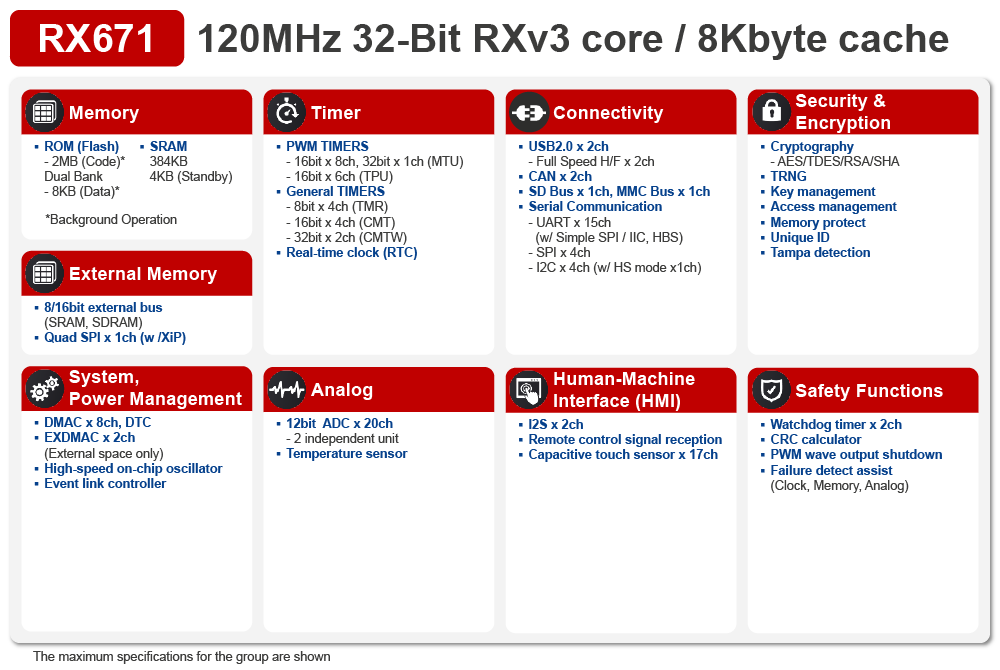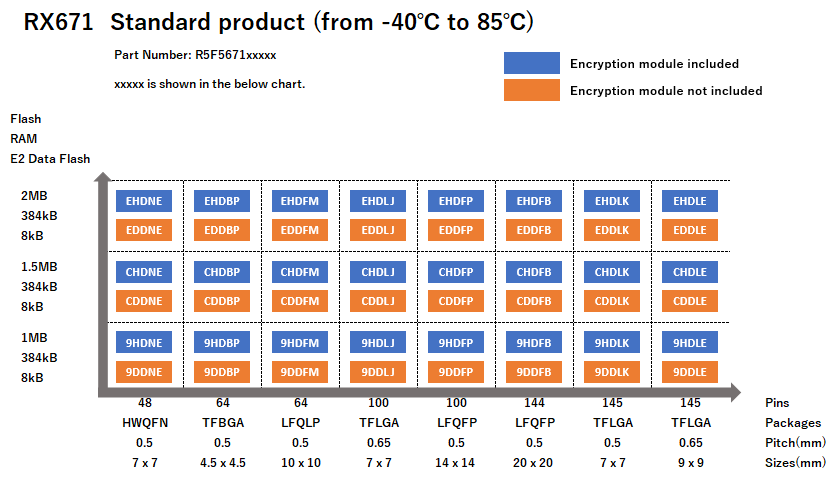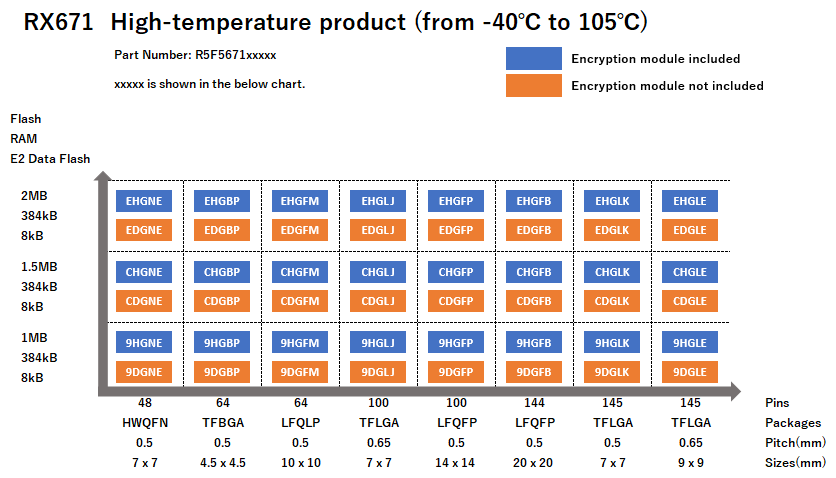Overview
Description
The RX671 group microcontrollers deliver superior real-time performance with the RXv3 core running at 120MHz. The HMI functions enable contactless operation by proximity switches and voice recognition, making it possible to realize hygienic HMI suitable for the new normal. A wide variety of packages, including the 4.5mm x 4.5mm 64-pin TFBGA, is all equipped with 2MB flash memory and 384KB SRAM to meet a wide range of needs with a single chip.
Features
- 120MHz RXv3 core (707 CoreMark, 48.8 CoreMark/mA), double-precision FPU, and register bank save function that speeds up interrupt response
- 2MB flash memory (60MHz read access, dual bank function), 384KB SRAM
- 48-pin to 176-pin package lineup including ultra-small 64-pin TFBGA (4.5mm x 4.5mm)
- Capacitive touch sensing unit and serial sound interface
- SD host interface, USB 2.0 full speed, CAN 2ch, and QSPI supporting XIP mode
- Encryption engine (AES, RSA, ECC, SHA, etc.), key management, access management circuit, flash memory protection
- 2.7V to 3.6V single supply operation
- Operating temperature: -40°C to 85°C or -40°C to 105°C
Comparison
Applications
Design & Development
Software & Tools
Sample Code
Boards & Kits
Models
ECAD Models
Schematic symbols, PCB footprints, and 3D CAD models from SamacSys can be found by clicking on the CAD Model links in the Product Options table. If a symbol or model isn't available, it can be requested directly from SamacSys.

Support

Support Communities
Support Communities
-
RX671 replace USB VBUS pin with GPIO
Hello, I am currently using the R5F5671HxFB MCU for a design. I would like to use the I2C2 peripheral and USB peripheral simultaneously. My MCU is not powerd by the USB but self-powered. So that VBUS must be sensed from the USB peripheral. But the issue is that both ...
Nov 7, 2023 -
How to test DRAM on the RX671 starter kit+ with e2 studio?
Hello, I've installed the e2 studio for Rx671 starter Kit+. I downloaded the compressed codes from the below link. However, I haven't found an example program to test DRAM on the board. RX671 Renesas Starter Kit Sample Code (e² studio for CC-RX) Rev.1.00 - Sample Code ...
Jun 17, 2022 -
RX671 SSIE Port Configuration
Hi All, I am trying to use SSIE on RX671 to communicate with Codec IC. While configuring ports for SSIE, I confused about how to select ports for it. For example, regarding to the hardware manual, I found that both PC7 and P17 can be set as SSITXD0 port, therefore ...
Nov 21, 2023
FAQs
-
Evaluation Boards for RX671
The following two boards allow RX671 evaluation. Target Board for RX671: Board that enables evaluation to be performed simply since it does not require a debugger. It includes a through hole for a pin header to enable access to all MCU signal pins, and is also comes equipped with a ...
Sep 8, 2021 -
Target applications of RX671
The RX671 can implement many functions in an extremely small footprint, including voice recognition, capacitive touch sensor, and cloud connection via wireless communication, making it suitable for a wide range of applications including home automation, HVAC controllers, smart meters or flowmeters, and Wi-Fi compatible devices such as robot vacuum ...
Sep 8, 2021 -
Remote control by voice solution of RX671
The RX671 includes a serial sound interface to provide support for digital input and output of audio data. Furthermore, it can provide accurate voice recognition even in noisy environments without an Internet connection and external memory by combining voice recognition middleware and noise reduction middleware developed by our partners. The ...
Sep 8, 2021
Videos & Training
This video introduces the reference design for serial TFT-LCD QVGA display and capacitive touch functions controlled by a single-chip RX MCU.
For more information, please refer to Serial LCD + Touch Reference Design.






